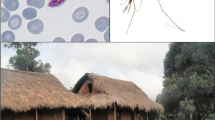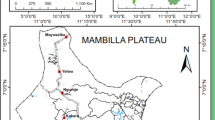Abstract
Malaria transmission was assessed in two rural communities, Kona and Afamanaso in Sekyere South district, Ashanti Region, in the forest zone of Ghana to provide baseline data for ongoing clinical studies and the evaluation of the effect of interventions. Altogether, 3,479 Anopheles gambiae and 1,157 Anopheles funestus were caught by human landing catches. Sporozoite rates determined by either microscopy of salivary glands or enzyme-linked immunosorbent assay (ELISA) for Plasmodium falciparum in the two villages were 6.6% vs. 8.9% for the main vector A. gambiae and 3.2% vs. 6.3% for A. funestus. ELISA tests of dissected specimens compared to microscopy of salivary glands were 1.3 and 2.0 times more positive for A. gambiae and A. funestus, respectively. Plasmodium infections of 122 microscopically positive salivary glands of A. gambiae were identified by real-time PCR as 95 (77.9%) P. falciparum, 7 (5.7%) Plasmodium malariae, 7 (5.7%) Plasmodium ovale and 1 (0.8%) mixed infection of P. falciparum and P. malariae. Transmission in the area was found to be intense and perennial with some seasonal variations during the study period from Dec. 2003 to Aug. 2005. Although the two villages were only 10 km apart from each other, Annual Biting Rates (ABRs) and Annual Entomological Inoculation Rates (AEIRs) were much higher at Afamanaso (11,643 vs. 866) than at Kona (5,329 vs. 490). Most of the transmission (91.4%) occurred during bedtime hours from 21 to 6 h. It is important to note that there was still a substantial transmission before 21 h with AEIRs of 57.3 at Afamanso and 38.7 at Kona. The distribution of impregnated bednets alone, therefore, may not be sufficiently effective.




Similar content being viewed by others
References
Afari EA, Appawu M, Dunho S, Baffoe-Wilmot A (1995) Malaria infection, morbidity and transmission in two ecological zones Southern Ghana. Afr J Health Sci 2:312–315
Appawu MA, Baffoe-Wilmot A, Afari EA, Dunyo S, Koram KA, Nkrumah FK (2001) Malaria vector studies in two ecological zones in southern Ghana. Afr Entomol 9:59–65
Appawu MA, Bosompem KM, Dadzie S, McKakpo US, Anim-Baidoo I, Dykstra E, Szumlas DE, Rogers WO, Koram K, Fryauff DJ (2003) Detection of malaria sporozoites by standard ELISA and VecTestTM dipstick assay in field-collected anopheline mosquitoes from a malaria endemic site in Ghana. Trop Med Int Health 8:1012–1017
Appawu M, Owusu-Agyei S, Dadzie S, Asoala V, Anto F, Koram K, Rogers W, Nkrumah F, Hoffman SL, Fryauff DJ (2004) Malaria transmission dynamics at a site in northern Ghana proposed for testing malaria vaccines. Trop Med Int Health 9:164–170
Asante FA, Asenso-Okyere K, d’Almeida S, Mwabu G, Okorosobo T (2004) Economic burden of malaria in the African region: evidence from Ghana. Commun Dis Bull Afr Region 2(4):1–4
Browne EN, Frimpong E, Sievertsen J, Hagen J, Hamelmann C, Dietz K, Horstmann RD, Burchard GD (2000) Malariometric update for the rainforest and savanna of Ashanti region, Ghana. Ann Trop Med Parasitol 94:15–22
De Souza D, Kelly-Hope l, Lawson B, Wilson M, Boakye D (2010) Environmental factors associated with the distribution of Anopheles gambiae s.s. in Ghana; an important vector of lymphatic filariasis and malaria. PLoS One 5(3):e9927
Detinova TS (1962) Age grouping methods in Diptera of medical importance with special reference to some vectors of malaria. Monogr Ser World Health Organ 47:13–191
Ghana Statistical Service (2000) Ghana living standards survey. Report of the fourth round (GLSS4) 1–192. Accra.
Gillies MT, de Meillon B (1968) The Anophelinae of Africa, South of the Sahara. Publ S Afr Inst Med Res 54:1–343
Gillies MT, Coetzee M (1987) A supplement to the Anophelinae of Africa south of the Sahara (Afrotropical Region). South Africa Institute for Medical Research 55:1–143
Kreuels B, Kobbe R, Adjei S, Kreuzberg C, von Reden C, Bäter K, Klug S, Busch W, Adjei O, May J (2008) Spatial variation of malaria incidence in young children from a geographically homogeneous area with high endemicity. J Infect Dis 197:85–93
Mangold KA, Manson RU, Koay ESC, Stephens L, Regner MA, Thomas RB, Peterson LR, Kaul KL (2005) Real-time PCR for detection and identification of Plasmodium spp. J Clin Microbiol 43:2435–2440
Okoye PN, Wilson MD, Boaky DA, Brown CA (2005) Impact of the Okyereko irrigation project in Ghana on the risk of human malaria infection by Anopheles species (Diptera: Culicidae). Afr Entomol 13:249–253
Owusu-Agyei S, Asante KP, Adjuik M, Adjei G, Awini E, Adams M, Newton S, Dosoo D, Dery D, Agyeman-Budu A, Gyapong J, Brian Greenwood B, Chandramohan D (2009) Epidemiology of malaria in the forest-savanna transitional zone of Ghana. Malar J 8:220
Sachs L (1999) Angewandte Statistik. Anwendung statistischer Methoden. Springer, Berlin
Scott JA, Brogdon WG, Collins FH (1993) Identification of single specimens of the Anopheles gambiae complex by the polymerase chain reaction. Am J Trop Med Hyg 49:520–529
Tuno N, Kjaerandsen J, Badu K, Kruppa T (2010) Blood-feeding behavior of Anopheles gambiae and Anopheles melas in Ghana, western Africa. J Med Entomol 47:28–31
Wirtz R (1987) Comparative testing of monoclonal antibodies against Plasmodium falciparum sporozoites for ELISA development. Bull World Health Organ 1987(65):39–45
Yawson AE, McCall PJ, Wilson MD, Donnelly MJ (2004) Species abundance and insecticide resistance of Anopheles gambiae in selected areas of Ghana and Burkina Faso. Med Vet Entomol 18:372–377
Acknowledgements
The study was partially funded by the Bundesministerium für Bildung und Forschung (grant 01KA0202). We are indebted to the vector collectors and the people in Kona and Afamanaso for continuous cooperation. We appreciate the support of the staff of Kumasi Centre for Collaborative Research in Tropical Medicine (KCCR). In particular we acknowledge the assistance of Dr. Christof Berberich, head of KCCR laboratories. Visits of Rolf Garms in Ghana were made possible by support of the German Senior Experten Service in 2003, 2005 and 2006. Ayimbire Abonuusum thanks the Bernhard Nocht Institute for Tropical Medicine for a 1-year scholarship and research stay in Hamburg, Germany and the Kwame Nkrumah University of Science and Technology, Kumasi, Ghana for a PhD grant. We thank Dr. Jean Pierre Lin for proofreading of the final version of the manuscript.
Author information
Authors and Affiliations
Corresponding author
Rights and permissions
About this article
Cite this article
Abonuusum, A., Owusu-Daako, K., Tannich, E. et al. Malaria transmission in two rural communities in the forest zone of Ghana. Parasitol Res 108, 1465–1471 (2011). https://doi.org/10.1007/s00436-010-2195-1
Received:
Accepted:
Published:
Issue Date:
DOI: https://doi.org/10.1007/s00436-010-2195-1




